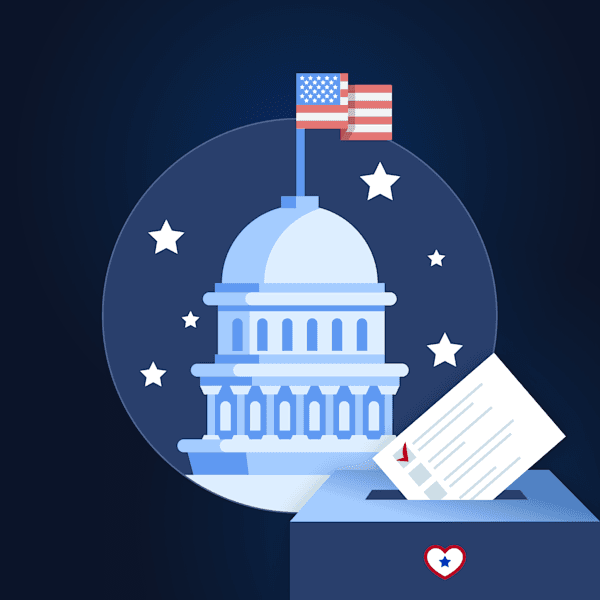
The Psychology of Voting: What Motivates People to Vote
Voting is never just a rational calculation. Behind every ballot cast is a complex blend of motivators ranging from identity and emotions to the stories we tell ourselves about what matters. Understanding the psychology of voting is crucial because it explains not just why people turn out to vote, but also how they make decisions once they show up at the polls.
For everyday citizens, these insights can help make voting feel more intentional. For candidates and organizers, they build the foundation of effective get-out-the-vote (GOTV) efforts.
In this guide, we’ll explore what motivates people to vote, the outside influences that shape choices, the barriers that keep people home, and how campaigns can use psychology to mobilize supporters.
What Motivates People to Vote?
Some may think of voting as casting a ballot for one party or another.
However, people’s electoral decisions begin with much deeper motivations, like:
Civic Duty and Responsibility: According to the Pew Research Center, most Americans say voting is a key part of good citizenship. For these voters, casting a ballot is about responsibility as much as choice.
Identity and Self-Expression: Voting can signal who we are, our values, cultural background, or political identity. It creates belonging within a community.
Empowerment: Casting a ballot reinforces that individuals have a voice in shaping the future. This sense of agency is especially important for young or historically underrepresented voters.
Emotional Drivers: Fear of negative outcomes, hope for change, anger at the status quo, or pride in participating can all be powerful motivators.
Most people vote because it feels like the right thing to do, and it’s a way to express who they are and what they believe in. It can also feel like a chance to make a difference and incite change in our communities. Voting choices don’t happen in a vacuum, though. The way people vote is influenced by the world around us, too.
Outside Influences on Voting Behavior
Our friends, family, the media, and even the tone of a campaign all shape how we view the choices on our ballots. These outside influences can reinforce our natural motivations or push us in a completely different direction.
Some external aspects of our voting choices include:
Peer Pressure and Social Norms: People are more likely to vote if their friends, family, or neighbors do.
Media Narratives: Coverage can shape how voters view candidates and issues. Independent campaigns often struggle here, but digital platforms provide new opportunities.
Campaign Messaging: From canvassing to digital ads, repeated contact builds familiarity and can tip undecided voters.
Social Media Influence: As of 2025, about half of American adults get their political news at least sometimes from social platforms. Digital influence on politics can either inspire or mislead voters.
Together, these outside influences remind us that voting is a social activity. From the media we consume to the people we trust, the world around us plays a powerful role in shaping how we see candidates and issues.
LEARN MORE: Explore how voter mobilization works in practice.
Making the Choice: Rational vs. Emotional Drivers
After personal motivations and outside influences come together (and sometimes, clash), voters still face the ultimate question: Who do I actually vote for?
Final decision-making is rarely just about one factor. It’s a mix of logic, shortcuts, and gut feelings.
Key ways people decide how to fill out a ballot include:
Issue-Based Voting: Choosing the candidate who aligns with their specific priorities, like climate change, healthcare, or local schools.
Candidate Qualities: Assessing traits such as honesty, competence, or relatability.
Party Loyalty: Falling back on party affiliation as a trusted shortcut.
Cognitive Shortcuts & Biases: Using mental habits like confirmation bias (seeking what we already believe), bandwagon effect (backing the perceived winner), or anchoring (clinging to first impressions).
Voters bring both their hearts and their heads into the ballot box. Sometimes emotions drive the choice. Other times, reason or habit leads the way. But almost always, it’s a mix of both.
The Role of Demographics in Voting Behavior
Demographics strongly shape motivations and turnout.
Crucial demographic variables that impact how a person votes are:
Age: Younger voters often prioritize cost of living, climate change, and student debt, while older voters focus on Social Security and healthcare.
Education: Higher levels of education tend to correlate with greater political engagement.
Race, Gender, and Geography: Each influences priorities and voting blocs in distinct ways.
In a recent study, researchers found that race is the most consistent factor for predicting party affiliation, with white voters more often identifying as Republican, and Black voters typically aligning with Democrats. However, income, education, and gender are also important factors that influence a person’s affiliation.
Beyond affiliation, how someone actually votes is difficult to predict. Some research suggests having an increase in personal economic hardships due to inflation makes someone more likely to vote against an incumbent candidate, even if that goes against their usual party. But, just having a generally negative perception of the economy is less likely to sway a person’s vote.
LEARN MORE: See how voting blocs form and why they matter.
Barriers to Participation: Why Some People Don’t Vote
Even with strong motivations and outside influences, millions of eligible voters stay home on election day. Understanding the psychology behind non-participation is just as important as understanding why people do vote.
The main things keeping people out of the voting booth include:
Voter Apathy
Apathy is one of the biggest hurdles. In 2024, nearly 90 million eligible Americans didn’t vote in the general election. Local elections are even worse, with turnout rates averaging below 20% and even less than 10% in some areas, meaning community decisions are decided by just a handful of people.
Many people ultimately believe their single vote won’t make a difference or they feel disconnected from candidates who don’t speak to their priorities.
LEARN MORE: Explore how voting for Independent candidates can help break down voter apathy.
Structural and Systemic Barriers
It’s not always about disinterest. Practical obstacles also discourage participation. Complicated registration processes, restrictive ID laws, and elections scheduled at odd times, like off-cycle local races, can all make voting feel out of reach.
Research consistently shows that when voting is made more accessible via reforms like same-day voter registration, early voting, automatic voter registration, or mail-in ballots, turnout rises. For instance, some studies suggest that same-day voter registration (SDR) can increase voter turnout by around 3 to 7 percentage points, especially among young voters and historically marginalized groups.
Distrust and Disillusionment
Some people simply stay home because they feel politics is corrupt or unresponsive. In the United States, only about 22% of Americans say they trust the federal government to do what is right “just about always” or “most of the time.”
Confidence in election integrity plays a particularly critical role. A 2024 study by the States United Democracy Center linked voters’ pre-election confidence to actual voting behavior and concluded that up to 3.7 percentage points of turnout might have been lost due to low trust – that’s over 5 million votes.
This rampant distrust has been built through structural issues: long histories of disenfranchisement, unequal treatment of marginalized communities, and inconsistent voting administration create skepticism that persists across cycles.
Low turnout isn’t laziness. It’s psychology, trust, and systemic design. For organizers and candidates, tackling apathy means lowering practical barriers, restoring trust, and reminding people why their vote truly matters.
LEARN MORE: Understand the impact of voter turnout in local elections and how we can fix low rates.
Using Voter Psychology to Motivate Your Base
Here’s where psychology becomes practical. Organizers and Independent candidates can use insights from the psychology behind voting to boost turnout and build stronger campaigns:
Lean Into Civic Identity: Frame voting as a responsibility to the community. Remind supporters: “Your neighbors are counting on you.”
Inspire With Hope: Optimism is more sustainable than fear. Share a vision of positive change your campaign can deliver.
Harness Social Proof: Encourage pledges to vote, voting sticker selfies, or group trips to the polls. People are motivated by seeing others participate.
Build Habits Through Pride: Reinforce the good feelings tied to voting. Thank supporters and remind them their ballot made a difference.
Simplify the Process: Politics can feel overwhelming. Break issues down into clear, real-world impacts: “This policy lowers your utility bill” or “This decision funds your schools.”
At the end of the day, voting is human. By understanding what makes people feel hopeful, connected, and empowered, we can help turn intentions into real participation.
LEARN MORE: See more ways you can boost voter turnout in your community.
Why Understanding Voter Psychology Matters Now
The psychology of voting shows us that we don’t make decisions in a bubble. We’re all influenced by identity, emotions, peers, media, and the systems around us.
Social media and digital platforms are shaping political opinions for millions of people every day. Demographic shifts are bringing younger and more diverse voters to the forefront, each with their own priorities and motivations. And campaigns are increasingly using behavioral data to tailor outreach, raising both opportunities and questions about fairness and trust.
The takeaway is clear: the future of democracy depends on whether we use these lessons to empower voters rather than exploit them. For everyday citizens, it means being aware of the subtle forces shaping your choices. For civic leaders and reformers, it means designing systems and campaigns that lower barriers, rebuild trust, and make participation meaningful.
But understanding the psychology of voting is just the first step. At GoodParty.org, we empower people to take the next step by equipping everyday people with the tools, training, and community support to turn insights into action. From voter data reports to grassroots training and digital outreach tools, we’re here to make sure people, not parties, drive our democracy forward.
Photo by Sora Shimazaki
You’ve learned what motivates voters, now see how to act on it. Explore GoodParty.org and find tools designed to help you turn motivation into participation.

